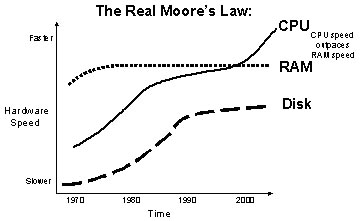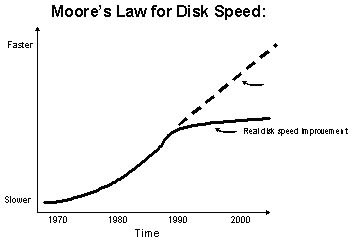 |
|
Oracle performance, hardware & RAM tuning optimization
Oracle Tips by Burleson Consulting |
Also see my notes on
using faster
hardware to correct an Oracle performance problem.
The
Oracle professional has always had to learn how improvements in
hardware will affect their Oracle database performance. This article
will explore the recent advances in hardware and show how Oracle
pros can leverage these new hardware technologies to improve the
performance of their databases.
At
a high-level, we see these important trends for Oracle:
-
All hardware
gets cheaper every year
-
CPU always
gets faster ? RAM and disk
does not
-
RAM-Disk will
soon replace platter disks
Let's take a closer look and understand how the hardware will affect
Oracle databases.
Moore's Law and Oracle
The
economics of server technology has changed radically over the past
40 years. In the 1960s, IBM dominated the server market with giant
mainframe servers that cost millions of dollars. These behemoth
mainframes were water-cooled and required a huge operations center
and a large staff to support their operations.
Gordon Moore, Director of the Research and Development Laboratories
at Fairchild Semiconductor, published a research paper titled
"Cramming more components into integrated circuits" in 1965. Moore
performed a linear regression on the rate of change in server
processing speed and costs, and noted an exponential growth in
processing power and an exponential reduction of processing costs.
This landmark paper gave birth to "Moore's Law," which postulated
that CPU power gets four times faster every three years

Figure 1. Moore's Law
Moore's
law has held true over the three decades since it was first
published, and
Moore's law has been extended to cover RAM
and disk storage costs as well.
However, the "real" Moore's Law cannot be boiled-down into a
one-size fits-all statement that everything always gets faster and
cheaper. Prices are always falling, but there are important
exceptions to Moore's Law, especially with regard to disk and RAM
technology (Figure 2).

Figure 2. The "real"
Moore's
Law
As
we can see, these curves are not linear and this trend has a
profound impact on the performance of Oracle databases. Let's take a
closer look.
Storage Costs
I'm
old enough to remember when punched cards were the prominent data
storage device. Every year I would get my income tax refund check on
a punched card and we would make Christmas trees from punched cards
in the "Data Processing" department.
College-aged kids have no idea what the term "Do not fold, spindle
or mutilate" means and they missed-out on the fun of dropping your
card deck on the floor and using the giant collating machines to
re-sequence them.
In
1985, a 1.2 gigabyte (GB) disk (the IBM-3380
disk) sold for more than $250,000.
![[shrinking+gigabytes.jpg]](images/two_gigabytes_1980_2010.jpg)
Today, you can buy 100 GB disks
for $200, and 100 GB of RAM Disk (solid-state disk) for $100,000.
We
see the following trends for Oracle disk in this decade:
-
Disk storage
costs fall 10x every year.
-
Magnetic-coated spinning platters are obsolete and cannot go
faster
-
RAM-SAN
replaces disk by 2008.
Note the change to Moore's Law for disks show the limitations of the
spinning platter technology (figure 3).

Figure 3. Moore's Law for disk
Platters can only spin so fast without becoming aerodynamic and the
disk vendors were hard-pressed to keep their technology improving in
speed. Their solution was to add a RAM
front-end to their disk arrays and sophisticated asynchronous
read-write software to provide the illusion of faster hardware
performance.
RAM
Costs
Today, you can buy 100 GB of RAM
for only $100,000, with access times 6,000 greater than traditional
disk devices. By 2013, a gigabyte of RAM
will cost the same as a gigabyte of disk today (about $200). RAM I/O
bandwidth capacity doubles every ten years, making the 128-bit
architecture due in about 2015:
Decade
Bandwidth
1970?s
8 bit
1980?s
16 bit
1990?s
32 bit
2000?s
64 bit
2010?s
128 bit
Note that Moore's Law does not apply at all to RAM and the speed has
been fixed for nearly 30 years.

Figure 4. Moore's Law for RAM
Because CPU speed continues to outpace memory speed, RAM subsystems
must be localized to keep the CPUs running at full capacity.
Processor Costs
The
same trend also exists for processor costs and speed. In the 1970s,
a 4-way SMP processor costs over $3,000,000. Today, the same CPU can
be purchased for under $3,0000. CPUs continue to increase speed by
four times as much every three years and cut cost in half.
So,
with this ongoing improvement in speed and rapidly declining costs,
where does the Oracle shop decide to adapt to a new technology? This
is a very important question to the Oracle professional, and one
that warrants careful investigation. Here is how the hardware is
going to change our lives with Oracle in the next few years:
-
CPU speed
continues to outpace memory speed. This means that RAM
sub-systems must be localized to keep the CPU's running at full
capacity and that RAM will move
out of the data buffer caches and in to the back-end disks.
-
Platter disks
are being replaced by
solid-state RAM disk. Within the next decade all
Oracle databases will be 100% solid-state.
-
Oracle
databases are shifting from being I/O-bound to CPU-bound as a
result of improved data caching. This is reflected in the new
cpu_cost feature of the Oracle10g SQL optimizer.
-
Using
hardware to correct Oracle performance problems has become
increasing attractive to management.
Let's take a closer look at how the super cheap, super fast hardware
is changing Oracle tuning activities:
Hardware hits the Oracle bottlenecks
Remember, every Oracle database has a bottleneck, no matter how well
it is tuned, and a quick look at the top five timed events will
reveal the bottleneck. Remember, even a properly-tuned Oracle
database system has a bottleneck (sometimes obvious from an
examination of your top-5 timed events), and the ONLY
way to speed-up a well-tuned Oracle database is to hit the
bottleneck.
-
Faster CPU
will speed-up ANY CPU-Bound Oracle database.
-
High-speed
Solid-state disk will speed up ANY I/O-bound Oracle database.
-
Faster
network will speed-up ANY "SQL*Net" bound Oracle database.
For
example, here is a CPU-bound Oracle10g database:
~~~~~~~~~~~~~~~~~ % Total
Event Waits Time (s) Ela Time
---------------------------------- ------------ ----------- --------
CPU time 4,851 4,042 55.76
db file sequential read 1,968 1,997 27.55
log file sync 299,097 369 5.08
db file scattered read 53,031 330 4.55
log file parallel write 302,680 190 2.62
Assuming that the library cache and the SQL are already optimized,
more CPU's or faster CPUs will improve the performance of this
database.
The
super-cheap Intel Itanium2 processors are making huge inroads for
these types of Oracle databases. Last month I upgraded a CPU-bound
database (already SQL tuned) to these faster 64-bit processors and
their batch jobs went from 2 hours to less than 15 minutes.
But
what about an Oracle database that needs tuning? Is it "legitimate"
to throw hardware at a poorly-tuned database? Let's take a closer
look.
Using Hardware as an Alternative to Oracle tuning?
Throwing hardware at an Oracle problem is a legitimate management
decision, and in some cases a cost-effective one, especially when
the database required a huge amount of manual effort.
For
example, when the schema design is messed-up, even materialized
views may fail to correct the performance issues. In my experience,
IT management DOES NOT want to hear about an expensive re-design of
the database for several reasons:
-
Fear of Blame
-- No manager wants to admit that a bad database design was
implemented under their watch.
-
High Downtime
-- The time to re-implement a table re-design can mean DAYS of
downtime
-
High Cost --
If the crappy implementation costs $200k, what do you think the
chances are that management will spend the money all over again
to re-design the system properly? Zero.
These are the shops that want a fast, save-face approach to
improving performance, and like it or not, it happens every day.
Just last week I had a client who was having a huge CPU bottleneck,
and the root cause was excessive parsing and really sub-optimal SQL
execution plans. They chose to spend $50k for faster processors (15
minutes to fix) rather than spend $100k to tune 2,000 SQL statements
(6 weeks to fix).
Now
does that make sense? Well, it depends on how you look at it. From a
management perspective it made sense as they saved $50k and got a
fast, unobtrusive solution to a complex problem.
Was
it elegant, heck no! Was it the "right" thing to do? You be the
judge...
Oracle professionals cannot ignore the economic reality of database
tuning. Time and time again, it's too costly (in both time and
money) for a shop to tune their SQL.
